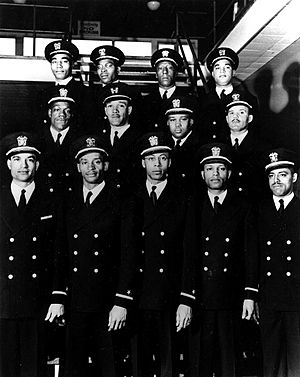Golden Thirteen facts for kids
Quick facts for kids The Golden Thirteen |
|
|---|---|

The Golden Thirteen, photographed on 17 March 1944. Top row: John Walter Reagan, Jesse Walter Arbor, Dalton Louis Baugh, Frank Ellis Sublett. Middle row: Graham Edward Martin, Charles Byrd Lear, Phillip George Barnes, Reginald E. Goodwin. Bottom row: James Edward Hair, Samuel Edward Barnes, George Clinton Cooper, William Sylvester White, Dennis Denmark Nelson.
|
|
| Active | 1944 - |
| Country | United States of America |
| Branch | Navy |
The Golden Thirteen were a special group of thirteen African American men. They made history in the United States Navy. In 1944, they became the very first African American officers in the Navy. This was a huge step forward because, for a long time, African Americans were not allowed to become officers.
Contents
A History of Service and Change
For many years, African Americans served in the U.S. Navy. However, after World War I, they were not allowed to join for a while. From 1919 to 1932, black men could not enlist. When they could join again, they were limited to certain jobs. These jobs were usually in the Messman's and Steward's branches. This meant they were kept separate from other sailors. It also stopped them from becoming officers.
Fighting for Equal Rights
In June 1941, President Franklin D. Roosevelt took an important step. He signed an executive order called Executive Order 8802. This order made it illegal for any government agency to treat people unfairly because of their race. This was a big win for civil rights.
Thanks to protests from civil rights leaders, things slowly began to change. Black newspapers also put pressure on the Navy. In April 1942, the Navy finally allowed black men to join general service roles. This was the first time this had happened in many years.
The Officer Training Program
In January 1944, the Navy started a special officer training course. This was for 16 African American enlisted men. First Lady Eleanor Roosevelt and Assistant Secretary of the Navy Adlai Stevenson helped make this happen. The training took place at Camp Robert Smalls in Illinois. This camp is now known as Great Lakes Naval Training Station.
Overcoming Challenges
Normally, this training lasted 16 weeks. But for the black cadets, it was cut short to only 8 weeks. Some people in the Navy wanted them to fail. The cadets realized this. So, they covered their barracks windows and studied all night long.
When they took their tests, all 16 cadets passed with high scores. The people in charge were surprised. They didn't believe that an all-black class could score higher than an all-white one. So, the black sailors had to take their tests again. Once more, all 16 passed. Their average score at graduation was very high, at 3.89.
Becoming Officers
Even though all sixteen men passed the course, only twelve were officially made officers in March 1944. They were called "Ensigns." These included:
- John Walter Reagan
- Jesse Walter Arbor
- Dalton Louis Baugh, Sr.
- Frank Ellis Sublett
- Graham Edward Martin
- Phillip George Barnes
- Reginald E. Goodwin
- James Edward Hair
- Samuel Edward Barnes
- George Clinton Cooper
- William S. White
- Dennis Denmark Nelson
One other man, Charles Byrd Lear, became a Warrant Officer. At the time, Navy rules did not allow black officers on combat ships. So, these early black officers often worked managing labor groups on shore.
After the War
In 1948, President Harry S. Truman officially ended segregation in the U.S. military. This meant that people of all races could serve together. When the Golden Thirteen became officers, about 100,000 African American men were serving in the Navy. Frank E. Sublett was the last living member of the Golden Thirteen. He passed away in 2006.
The Golden Thirteen's Lasting Impact
The Golden Thirteen left an important legacy. In 1987, the U.S. Navy brought seven living members together. They dedicated a building in their honor. This building is at Naval Station Great Lakes in Illinois. Today, Building 1405 at Great Lakes is named "The Golden Thirteen." This is where new recruits first arrive for basic training.
In 2006, work began on a World War II memorial in North Chicago, Illinois. This memorial honors the Golden Thirteen and Dorie Miller. It helps remember their brave service and the changes they brought about.

